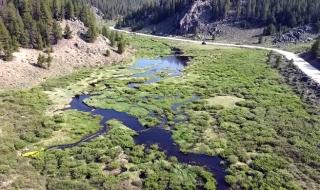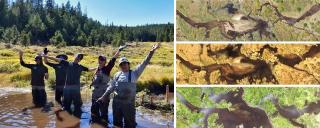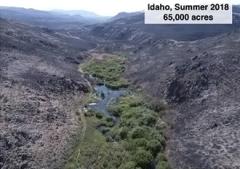
When you think of beavers, what comes to mind? Busy engineers, pesky rodents, or how about firefighters?
You may already know that beavers are a keystone species, meaning many other species of animals, plants and people in the environment depend on them and the habitat they build. But do you know that they also might be the key to helping reduce our wildfire crisis?
The landscape of the west used to have millions more beavers than it does today. The fur trade in the 1800s and early 1900s drastically reduced their population.

The loss of beaver populations had a dramatic negative impact on the landscape, creating trouble in the watersheds of the western United States. Beaver dams help slow the flow of spring run-off, reserving water to be used later in the summer when water is often scarce. They raise the water table to keep water on the landscape, creating and preserving wetland habitat for other species. Without the dams, streambanks are eroded, and wetlands are lost, causing fresh water to drain from the landscape too quickly, sometimes causing flooding in the spring, and leaving the land dry by late summer and fall.
Riparian plants like willow and aspen help stabilize streambanks, provide food for wildlife, and are culturally significant plants for many indigenous communities. These plants are dependent on beaver dams, and without them, plants that favor dryer conditions move in and the connection between streams and wetlands deteriorates.
As beavers create and maintain wetlands, the outcomes are vast. A lack of beavers has resulted in an increased intensity of drought and wildfires in the west as fires spread rapidly across parched landscapes. Wetlands act as natural fuel breaks, giving firefighters a chance for containment.

The ecosystems that beavers create are so effective at restoring wetlands and retaining water that land managers are mimicking their structures. One name for this is beaver-based restoration, and a type of mimicry structure is beaver dam analogues, or BDAs.
BDAs are man-made structures that imitate beaver dams, constructed with wooden fence posts and willows. This is a low-cost, low-maintenance, and fast-acting method to help prevent an area from burning and it protects water quality. Rather than fighting with and trying to control nature, BDAs are a way to support and work with nature by mimicking natural processes and encouraging beavers to return to the landscape.
Many organizations have begun using beaver-based restoration techniques to restore floodplains and historic wetland areas, increasing resilience to potential wildfires. Some successful examples are the Tulalip Tribe in Washington State and the Grand Mesa, Uncompahgre, and Gunnison National Forest in Colorado.

Ashley Hom with the Forest Service co-leads Colorado’s largest beaver-based restoration project along with many partners. In just two years, this team built 316 beaver mimicry structures, about half of which were BDAs, and many of which were constructed by volunteers. They also restored historic canals, which are used by beavers as travel corridors and connect streams to floodplains and wetlands. This project re-wetted 45 acres of historic wetlands and improved 1.4 miles of riverscape.
Beaver-based restoration is an effective and natural way to reduce our wildfire crisis simply by keeping water on the land. In Idaho, for example, a wildfire stopped at the healthy, robust, beaver-created wetland. In the area without a dam, where the stream was reduced to a single thread, the entire area burned catastrophically. Beavers serve as a beacon of hope to help fight our wildfire crisis across the country.






